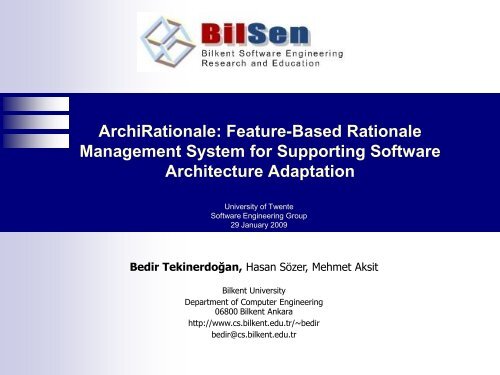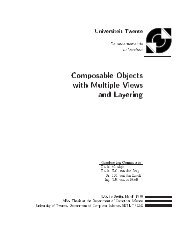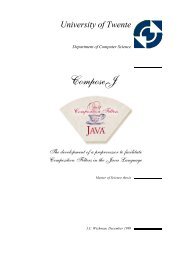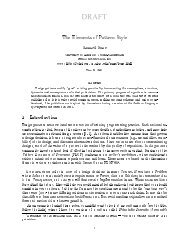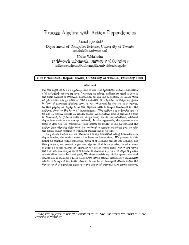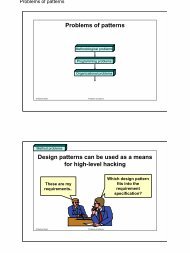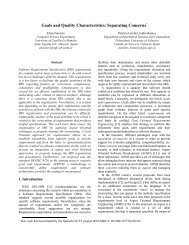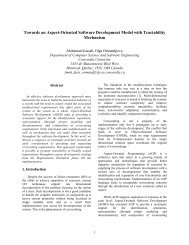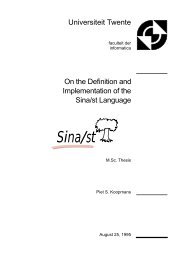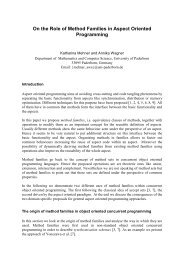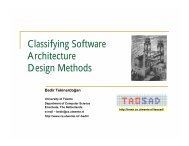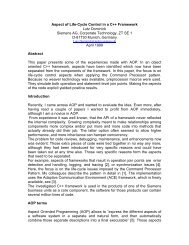slides - trese
slides - trese
slides - trese
Create successful ePaper yourself
Turn your PDF publications into a flip-book with our unique Google optimized e-Paper software.
ArchiRationale: Feature-Based Rationale<br />
Management System for Supporting Software<br />
Architecture Adaptation<br />
University of Twente<br />
Software Engineering Group<br />
29 January 2009<br />
Bedir Tekinerdoğan, Hasan Sözer, Mehmet Aksit<br />
Bilkent University<br />
Department of Computer Engineering<br />
06800 Bilkent Ankara<br />
http://www.cs.bilkent.edu.tr/~bedir<br />
bedir@cs.bilkent.edu.tr
Rationale for Software Architecture<br />
Improved understanding because of a higher level<br />
abstract specification<br />
Guides subsequent phases since it embodies earliest<br />
design decisions<br />
Supports stakeholder communication<br />
Support for large-grained reuse<br />
Enables to evaluate system before it is implemented<br />
Management of software development activities<br />
© Bedir Tekinerdoğan 2
Architectural Viewpoints<br />
Viewpoint:<br />
A pattern or template from which to construct<br />
individual views.<br />
View<br />
a model of the system from the perspective<br />
of one or more concerns which are held by<br />
one or more stakeholders<br />
has<br />
Concern<br />
1..*<br />
Stakeholder<br />
important to 1..*<br />
1..*<br />
used to cover<br />
identifies<br />
described by<br />
Architecture<br />
Architectural<br />
Description<br />
© Bedir Tekinerdoğan 3<br />
1..*<br />
1..*<br />
is addressed to<br />
Viewpoint<br />
conforms to<br />
1 1<br />
organized by<br />
View<br />
1..*<br />
participates in<br />
consists of 1..*<br />
Model
Organizing Views (Views and Beyond)<br />
An architect must consider the system in three ways:<br />
How is it structured as a set of implementation units?<br />
Module Views (Module viewtype)<br />
How is it structured as a set of elements that have run-time<br />
behavior and interactions?<br />
Component-and-connector views (C&C viewtype)<br />
How does it relate to non-software structures in its environment?<br />
Allocation views (allocation viewtype)<br />
© Bedir Tekinerdoğan 4
Architectural Documentation<br />
Views give us our first principle of architecture<br />
documentation:<br />
Document the relevant views,<br />
and then add information<br />
that applies to more than one view.<br />
Software Architecture<br />
Documentation<br />
View<br />
Transview<br />
Information<br />
© Bedir Tekinerdoğan 5
Software Architecture Patterns<br />
express a fundamental structural organization<br />
schemes for software systems.<br />
provide a set of predefined subsystems<br />
specify their responsibilities<br />
and include rules and guidelines for organizing the<br />
relationships between them<br />
© Bedir Tekinerdoğan 6
Architecture Evaluation Techniques<br />
Analytic Models<br />
Simulations<br />
Question-based<br />
Questionnaire-based<br />
List of general open questions that apply to all software<br />
architectures.<br />
Checklist-based<br />
detailed set of questions<br />
after experience of analyzing common set of systems<br />
usually domain specific<br />
Scenario-based analysis<br />
© Bedir Tekinerdoğan 7
The software architect<br />
software architect is currently equipped with a broad set of techniques to<br />
design a software architecture:<br />
Architectural Modeling (Views, ADLs)<br />
Architectural Patterns<br />
Architectural Evaluation Techniques<br />
Architectural Methods<br />
...<br />
Using these approaches the software architect makes a wide range of design<br />
decisions that leads to the selection of a particular design alternative.<br />
“I am the Architect. I created The Matrix. …"<br />
© Bedir Tekinerdoğan 8
Design Rationale<br />
The reasons behind the<br />
design decisions, the<br />
justification, the alternatives<br />
considered, the trade-offs<br />
evaluated, and the<br />
argumentation that led to the<br />
decision is defined as design<br />
rationale<br />
Software<br />
Architecture<br />
Architectural<br />
Components, Relations,<br />
Styles, Patterns,<br />
ADL<br />
Rationale<br />
© Bedir Tekinerdoğan 9
Design Rationale Management<br />
The explicit capturing, documentation and usage of the design rationale<br />
important for many different reasons such as design communication,<br />
design evolution, design maintenance, design verification, and design<br />
reuse<br />
In general practitioners recognize the importance of documenting and<br />
usage of design rationale to support the reasoning about design choices.<br />
Unfortunately architecture design rationale is still not being documented<br />
in a consistent manner<br />
methodology and tool support for design rationale capture and usage is<br />
necessary<br />
© Bedir Tekinerdoğan 10
Design Rationale Management System<br />
Rationale management systems enable the capturing,<br />
modelling and accessing of design rationale.<br />
Classification<br />
process-oriented rationale management system<br />
feature-oriented rationale management system<br />
© Bedir Tekinerdoğan 11
Process-Oriented Rationale Management Approaches<br />
Often applied for dynamic design domains in which the design<br />
principles are not well-established.<br />
there is no well-defined set of features or options. different new<br />
questions, arguments can be raised during the development process<br />
considers the design rationale usually as a history of the design<br />
process<br />
The representation of design rationale in this approach is usually<br />
graph-based in which the nodes represent questions, positions and<br />
arguments and the links the relations among these concepts.<br />
Examples: Ibis, QOC , DRL, PHI etc.<br />
© Bedir Tekinerdoğan 12
Feature-based Rationale Management Approaches<br />
evolved from the process-based rationale approaches<br />
but differ in the rationale capturing approach.<br />
In a feature-based rationale approach the design<br />
rationale is based on features of a system rather than<br />
the arguments raised during the development process.<br />
Feature-based rationale approaches are typically used<br />
for well-defined domains with established design<br />
rules.<br />
© Bedir Tekinerdoğan 13
Example Feature Diagram for Insurance Systems<br />
Corporation<br />
Realty<br />
Insurance Product<br />
Insured Object Coverage Payment<br />
Conditions Premium<br />
Movable<br />
Property<br />
Person<br />
Illness<br />
Life<br />
Unemployment<br />
Damage<br />
Loss<br />
Service<br />
© Bedir Tekinerdoğan 14<br />
Amount<br />
Legend:<br />
Own Risk<br />
Acceptance Exception<br />
mandatory feature<br />
optional feature<br />
Direct Periodical<br />
alternative feature<br />
or-feature<br />
Payee<br />
Person Corporation
Design Rationale - Focus<br />
In general the overall design rationale and its context<br />
becomes very large,<br />
and likewise it is impossible to capture and represent<br />
an entire design rationale explicitly<br />
Even if this would be possible, it is also not always<br />
necessary or desired to represent the complete design<br />
rationale.<br />
© Bedir Tekinerdoğan 15
The focus of this talk<br />
We expect that a software architecture is provided<br />
that needs to be adapted for particular quality concerns.<br />
The design rationale capturing process starts after<br />
the architecture design and<br />
considers then the design decisions, the alternatives and<br />
the argumentation behind the adaptation of the<br />
architecture<br />
As such we do not consider capturing design rationale<br />
from the initial requirements document to the<br />
architecture design<br />
© Bedir Tekinerdoğan 16
Context - Trader Project<br />
Industry-as-laboratory project<br />
Television Related Architecture Design to<br />
Enhance Reliability (Trader)<br />
Context: Embedded Systems and in particular<br />
consumer electronics (Digital TV)<br />
Period: Sept.2004-Aug. 2009<br />
10 partners (industrial and academic)<br />
22 fte/yr, 7 PhDs, 2 Postdocs,<br />
around 3-4 miljon euro<br />
funded by The Netherlands Ministry of<br />
Economical Affairs under the Bsik programme<br />
ESI, Eindhoven:<br />
project location<br />
Carrying Industrial Partner<br />
© Bedir Tekinerdoğan 17
Reliability<br />
The probability that a system will continue to function without failure<br />
for a specified period in a specified environment.<br />
How to prevent failures?<br />
fault prevention<br />
fault removal<br />
fault tolerance<br />
delivered service<br />
deviates from<br />
the correct service<br />
system state that<br />
may cause a failure<br />
the cause of<br />
an error<br />
ANSI/IEEE, "Standard Glossary of Software Engineering Terminology,” STD-729-1991, ANSI /IEEE, 1991.<br />
Failure<br />
Error<br />
Fault<br />
propagation<br />
activation<br />
© Bedir Tekinerdoğan 18
Fault-Tolerant Design<br />
designing a system so it will continue to operate,<br />
possibly at a reduced level,<br />
rather than failing completely, when some part of the<br />
system has an error.<br />
Fault Tolerance:<br />
Error detection<br />
Diagnosis<br />
Recovery<br />
© Bedir Tekinerdoğan 19
Example - Mediaplayer<br />
Stream reads the input media by<br />
bytes/blocks and provides buffering, seek<br />
and skip functions.<br />
Demuxer demultiplexes (separates) the<br />
input to audio and video channels, and<br />
reads them from buffered packages.<br />
Mplayer connects the other modules, and<br />
maintains the synchronization of audio and<br />
video.<br />
Libmpcodecs embodies the set of available<br />
codecs.<br />
Libvo displays video frames.<br />
Libao controls the playing of audio.<br />
Gui provides the graphical user interface of<br />
MPlayer.<br />
enhance the architecture for fault tolerance<br />
© Bedir Tekinerdoğan 20
Adapting Architecture<br />
Architectural<br />
Components, Relations,<br />
Styles, Patterns,<br />
ADL<br />
Adapt....<br />
each fault-tolerant architecture<br />
will be the result of a set of<br />
design decisions<br />
and there is a rationale behind<br />
these decisions (e.g. to reduce<br />
cost, to achieve high<br />
availability/performance).<br />
© Bedir Tekinerdoğan 21
Alternative Recovery Designs<br />
?<br />
© Bedir Tekinerdoğan 22
Analysis vs. Design Rationale<br />
How to select and analyze a<br />
particular design alternative<br />
(alternative space analysis)<br />
What decisions are taken during<br />
the selection of the design<br />
alternative?<br />
(design rationale management)<br />
© Bedir Tekinerdoğan 23
Design Rationale Metamodel<br />
Feature Modelling defines the<br />
metamodel for defining feature models<br />
Feature Decisions part includes the<br />
concepts for selecting features and<br />
capturing the rationale behind these<br />
features<br />
Design Alternatives part represents<br />
the approaches for realizing the<br />
selected feature decisions in the<br />
Feature Decision Rationale<br />
Architecture Design part of the<br />
metamodel includes the concept for<br />
modelling architectures.<br />
Feature Modeling<br />
Family Feature Model<br />
-name<br />
-constraints<br />
Architecture Design Design Alternatives<br />
© Bedir Tekinerdoğan 24<br />
Architecture<br />
described<br />
by<br />
1..*<br />
1..*<br />
-name<br />
Feature<br />
-name<br />
-cardinality<br />
0..*<br />
FeatureGroup<br />
Architectural Description<br />
selects<br />
applied to<br />
Feature Decision<br />
-id<br />
-name<br />
-type<br />
-state<br />
-category<br />
Application Feature Model<br />
-id<br />
-name<br />
-state<br />
-id<br />
-name<br />
-type<br />
-state<br />
-id<br />
-name<br />
Design Template<br />
0..*<br />
Design Alternative<br />
provides solution<br />
to<br />
-argument<br />
-assumption<br />
Feature Decisions<br />
Feature Decision Rationale<br />
Feature Decision Criteria<br />
-description<br />
Design Template Criteria<br />
-description<br />
Design Alternative Rationale<br />
-argument<br />
-assumption<br />
using
ArchiRationale: Integrated Tool<br />
Feature-based rationale<br />
management tool<br />
built in the Eclipse Platform<br />
To implement the rationale<br />
management approach<br />
customizes and integrates several<br />
open-source tools that are<br />
provided as Eclipse plug-ins<br />
and all based on the XML<br />
technology.<br />
The activities of the approach Tool support<br />
Architecture Design ArchStudio<br />
Modeling Architectural Tactic Space<br />
of Quality<br />
XFeature<br />
Capturing Design Rationale XFeature,<br />
Recovery Designer<br />
Design Alternative Application ArchStudio<br />
Accessing Design Rationale XQuery<br />
Outline View<br />
(Fault Tolerance<br />
Family Model)<br />
Editing Pane<br />
(Fault Tolerance<br />
Family Model)<br />
Navigator (Xfeature Models)<br />
XQuery<br />
perspective<br />
Arch-Studio<br />
perspective<br />
Properties Pane<br />
© Bedir Tekinerdoğan 25
The Approach<br />
Modeling/Preparation<br />
Architecture Design<br />
Modeling Architectural tactic space (family<br />
feature model)<br />
Capturing Design Rationale<br />
Instantiate familiy feature model (selected<br />
features) representing fault tolerant view<br />
For each feature selection define the<br />
rationale<br />
Set of feature selections define fault<br />
tolerance view<br />
Fault tolerance view is related to<br />
corresponding alternative design template Design<br />
© Bedir Tekinerdoğan 26<br />
Architecture<br />
Design<br />
Modeling<br />
Architectural Tactic<br />
Space of Quality<br />
Capturing Design Rationale<br />
Alternative<br />
Application<br />
KEY<br />
Software<br />
Architecture<br />
Design<br />
Domain Analysis<br />
Feature Decision<br />
Design Template<br />
Definition<br />
Design Alternative<br />
Selection<br />
Fault Tolerant<br />
Architecture +<br />
Rationale<br />
Family Feature<br />
Model<br />
Application<br />
Feature Model<br />
Design Template<br />
Design<br />
Alternatives<br />
Process Artefact Data<br />
Flow<br />
Conceptual<br />
Architecture<br />
Select and Apply<br />
Design Alternative
Modeling Architecture - ArchStudio<br />
ArchStudio<br />
open-source software and systems<br />
architecture development environment<br />
uses an XML-based architecture<br />
description language, xADL<br />
integrates several tools for modeling,<br />
visualizing, analyzing and<br />
implementing architectures that are<br />
expressed in xADL.<br />
we model the existing architecture<br />
design and design alternatives with the<br />
Archipelago tool of ArchStudio.<br />
Archipelago is a front-end tool that<br />
provides a graphical user interface to<br />
create, view and modify an<br />
architecture description specified in<br />
xADL.<br />
© Bedir Tekinerdoğan 27
Defining Feature Models<br />
XFeature:<br />
XFeature is a feature modeling tool which supports the<br />
modeling of product families and of the applications<br />
instantiated from them.<br />
It employs an XML-based approach to express the feature<br />
models and it uses XML schemas to express the metamodels.<br />
It is possible to customize the XFeature tool with respect to<br />
the type of feature diagrams that can be specified and the<br />
graphical notations that are used for representing feature<br />
models.<br />
We have customized the XFeature tool for ArchiRationale<br />
by specifying the meta-model of design rationale<br />
© Bedir Tekinerdoğan 28
Family Feature Model<br />
Architectural tactic is defined as<br />
characterization of architectural<br />
decisions that are needed to<br />
achieve a desired quality<br />
attribute response (e.g. Fault<br />
tolerance)<br />
Architectural tactics are derived<br />
using a domain analysis process<br />
and represented in a family<br />
feature model.<br />
Unlike existing feature-based<br />
rationale management<br />
approaches we focus on modeling<br />
quality features instead of product<br />
features<br />
© Bedir Tekinerdoğan 29<br />
transient<br />
KEY<br />
persistence<br />
recovery<br />
error type granularity technique<br />
permanent<br />
stable<br />
storage<br />
total<br />
compensation<br />
check-pointing<br />
uncoordinated coordinated communication<br />
induced<br />
feature<br />
global<br />
non-blocking<br />
local<br />
blocking<br />
backward<br />
recovery<br />
log-based<br />
forward<br />
recovery<br />
replication graceful<br />
degradation<br />
optional<br />
sub-feature<br />
pessimistic optimistic causal<br />
mandatory<br />
sub-feature<br />
alternative<br />
sub-features
XML-Based Customized Feature Modeling with XFeature<br />
Use meta-metamodel of X-<br />
Feature to define design rationale<br />
metamodel<br />
Based on design rationale metamodel<br />
define a Architectural Tactic<br />
Space (Family Model)<br />
Family Model is input to XSL<br />
program that generates a metamodel<br />
based on a provided family<br />
model. (e.g. Fault Tolerance<br />
Family Feature model).<br />
Fault tolerance views are defined<br />
based on Architectural Tactic<br />
Space Meta model.<br />
Feature<br />
Meta-Meta-Model<br />
(XML Schema)<br />
Design Rationale<br />
Meta-Model<br />
(XML Schema)<br />
Fault Tolerance View<br />
(Feature<br />
Fault<br />
Fault Diagram<br />
Tolerance View<br />
(Feature Diagram<br />
Tolerance - XML)<br />
- XML)<br />
View<br />
(Feature Diagram - XML)<br />
© Bedir Tekinerdoğan 30<br />
extends<br />
conforms-to<br />
input-to<br />
Fault Tolerance<br />
Architectural Tactic Space<br />
(Family Model - XML)<br />
Design Rationale<br />
Meta-Model Generator<br />
(XSD Generator- XSL Program)<br />
generates<br />
Fault Tolerance<br />
Architectural Tactic Space<br />
Meta Model<br />
(XML Schema)<br />
conforms-to
Modeling Family and Application Feature Model<br />
Fault Tolerance Family<br />
Model, which defines the<br />
technical space of fault<br />
tolerance.<br />
Several application fault<br />
tolerance models by selecting<br />
features from the family feature<br />
model<br />
Family Feature Model<br />
Application Feature Model<br />
© Bedir Tekinerdoğan 31
Fault Tolerance View<br />
Every feature diagram that is specified<br />
with respect to the Fault Tolerance<br />
architectural tactic space is a Fault<br />
Tolerance View<br />
A fault tolerance view captures and<br />
stores the design rationale related<br />
to selections and choices made<br />
with respect to the fault tolerance<br />
architectural tactic space<br />
A fault tolerance view relates to<br />
design template (modeled with the<br />
tools of ArchStudio, and stored as<br />
separate XML file).<br />
Design Template that corresponds to a Fault<br />
Tolerance Feature Model defined using ArchStudio<br />
© Bedir Tekinerdoğan 32
Two different layers of decisions<br />
decide on the features for<br />
recovery that need to be<br />
realized by the enhanced<br />
architecture.<br />
Decide on the decompostition<br />
of the architecture based on<br />
design template<br />
Example<br />
Select local recovery<br />
Decide which components need<br />
to be made recoverable<br />
© Bedir Tekinerdoğan 33<br />
transient<br />
KEY<br />
persistence<br />
recovery<br />
error type granularity technique<br />
stable<br />
storage<br />
total<br />
compensation<br />
check-pointing<br />
uncoordinated coordinated communication<br />
induced<br />
feature<br />
permanent<br />
global<br />
non-blocking<br />
local<br />
blocking<br />
backward<br />
recovery<br />
log-based<br />
forward<br />
recovery<br />
replication graceful<br />
degradation<br />
optional<br />
sub-feature<br />
pessimistic optimistic causal<br />
mandatory<br />
sub-feature<br />
alternative<br />
sub-features
Alternative Recovery Designs<br />
transient<br />
KEY<br />
persistence<br />
recovery<br />
error type granularity technique<br />
stable<br />
storage<br />
total<br />
compensation<br />
check-pointing<br />
uncoordinated coordinated communication<br />
induced<br />
feature<br />
permanent<br />
global<br />
non-blocking<br />
local<br />
blocking<br />
backward<br />
recovery<br />
log-based<br />
forward<br />
recovery<br />
replication graceful<br />
degradation<br />
optional<br />
sub-feature<br />
pessimistic optimistic causal<br />
mandatory<br />
sub-feature<br />
alternative<br />
sub-features<br />
© Bedir Tekinerdoğan 34
Adapting Architecture<br />
After a design template is selected, the<br />
next step is to adapt the architecture<br />
accordingly.<br />
Several additional design alternatives<br />
can exist for adapting the architecture.<br />
These alternatives are specific to the<br />
selected design template.<br />
It requires the evaluation of several<br />
criteria and dedicated analysis<br />
techniques.<br />
The design rationale at this step is<br />
basically formed by the criteria set<br />
being evaluated, the evaluation<br />
method (e.g. based on simulation or<br />
analytic models), types of formal<br />
models employed, their parameters,<br />
assumptions and the analysis results.<br />
We use RecoveryDesigner tool<br />
© Bedir Tekinerdoğan 35
Querying Design Rationale<br />
XQuery is a language to query XML data<br />
sources.<br />
XQuery Development Tools provides<br />
support of XQuery inside the Eclipse<br />
platform including code templates, semantic<br />
analysis, query validation and execution.<br />
Using the XQuery Development Tools, we<br />
have created and validated parameterized<br />
query functions that are defined to query<br />
XML data conforming to the ArchiRationale<br />
XML schemas created with the XFeature<br />
Tool.<br />
Quality Feature<br />
Model<br />
Design Rationale Database<br />
Design<br />
Alternatives<br />
Fault Tolerant<br />
Architecture +<br />
Rationale<br />
© Bedir Tekinerdoğan 36<br />
Queries<br />
User
Design Rationale Repository<br />
Artifacts delivered through the<br />
rationale process are stored in a<br />
repository and the necessary<br />
information can be queried. Design Rationale Database<br />
Function Description<br />
getDesignDecisions() Retrieve all the design<br />
decisions and their properties<br />
getDesignOptions() Retrieve all the design options<br />
and their properties<br />
getDecisionProperties(p) Retrieve a particular property<br />
regarding the design decisions<br />
getOptionProperties(p) Retrieve a particular property<br />
regarding the design options<br />
queryDecisionProperties(p,q) Retrieve the design decisions<br />
that contain the query text in<br />
the specified property<br />
queryOptionProperties(p,q) Retrieve the design options<br />
that contain the query text in<br />
the specified property<br />
Quality Feature<br />
Model<br />
Design<br />
Alternatives<br />
Fault Tolerant<br />
Architecture +<br />
Rationale<br />
© Bedir Tekinerdoğan 37<br />
Queries<br />
User
Characterization of ArchiRationale<br />
Focus on adaptation of<br />
architecture<br />
Defining rationale based<br />
on quality concern<br />
Focus on well-defined<br />
domain<br />
Goal Support for Design Adaptation<br />
System Type Feature-Based; Features are techniques to<br />
realize quality<br />
Services Design Documentation, Constraint<br />
Checking, Design Adaptation<br />
Represented<br />
Information<br />
Representation<br />
Method<br />
Feature Decisions, Design Options,<br />
Design Alternatives (three layers)<br />
Formal (features) and<br />
semi-formal (decisions)<br />
Capture Method Methodological by-product after the<br />
initial architecture has been designed<br />
Access Method User-Initiated<br />
Domain Techniques to implement Quality<br />
Concerns (Architectural Tactic Space)<br />
Design Type Adaptation<br />
Design Phase Post-Architecture Design,<br />
Architectural Maintenance<br />
Number of<br />
Designers<br />
© Bedir Tekinerdoğan 38<br />
Any<br />
Notation Feature Modeling; Architecture<br />
description, XML-based
Conclusion<br />
a meta-model that defines the concepts and the<br />
relations among the architecture and the rationale<br />
management system.<br />
a systematic rationale management approach for<br />
documenting and accessing the rationale for architecture<br />
design alternatives.<br />
Because the rationale system is focusing after the<br />
architecture design process, the approach is<br />
complementary and agnostic to the applied<br />
architecture design method.<br />
an integrated tool environment ArchiRationale that<br />
supports the capturing and access of design rationale<br />
and the related artefacts<br />
© Bedir Tekinerdoğan 39


